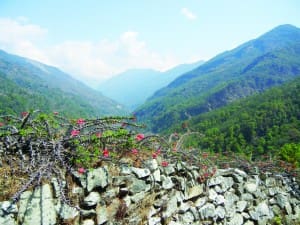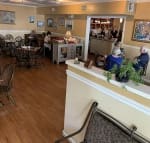NEPAL AND THE MYSTICAL HIMALAYAS
NEPAL AND THE MYSTICAL HIMALAYAS
“People do not decide to become extraordinary. They decide to accomplish extraordinary things.” Sir Edmund Hillary
All photos by Pam Euston.
My husband, Don, and I love to travel and in 2011 we decided to go to Nepal and Tibet. This was our fourth trip with Overseas Adventure Travel, a wonderful company that gets you off the beaten travel in small groups. For more information, visit their website at www.oattravel.com.
We departed JFK International Airport in New York on March 30, 2011, and sixteen hours later landed in Delhi, India where we stayed overnight. Next morning we headed back to the airport for the two hour flight to Kathmandu, Nepal’s capital and the country’s largest city, founded around 300 AD. It forms the hub of the surrounding Kathmandu Valley. We arrived at 3:00 pm and met our in-country guide, Sangeeta Prasai. She greeted us with “Namaste” which means “Hello” or more formerly, “I salute you”, and placed a pale yellow khata around each of our necks. This is common in Nepal and Tibet and the scarf is a symbol of friendship, welcome and respect. We boarded our bus and set off for the Gokarna Forest Resort. The one hour trip was quite an adventure in itself through one of the dirtiest, crowded and very congested cities we’ve ever encountered. They love honking horns here just as much as in Delhi and the city was a kaleidoscope of colors, smells, noise, pollution and perpetual movement.
An hour later we reached the sanctity of the Gokarna Forest Resort, a blissfully peaceful oasis amid all the noise and confusion of Kathmandu. This was at one time the private hunting lodge of the Nepalese royal family. That is until June 1, 2001, when a drunken Crown Prince Dipendra showed up at dinner and in a hail of bullets, killed ten members of the royal family, including his parents, King Birendra and Queen Aishwarya. He then shot himself and died two days later. Many believe Dipendra’s murderous drug-fueled rage was prompted by his parent’s disapproval of the woman he wanted to marry.
After getting settled, we met Sangeeta for an orientation and filled out our visas for our next stop, Tibet. We learned some more Nepalese words…most important was “Chhai na” which means “No, I don’t have” but in the case of American tourists translates as “I don’t want it, don’t need it and I’m out of money!”
Nepal is one of the world’s oldest and most extraordinary countries; a geographical wonder and an ethnological crossroads. Contrast is the common denominator, the unifying thread linking a profusion of customs, cultures, peoples, languages and landscapes. The fabric of Kathmandu’s society is being re-woven to incorporate modern influences, motorized transportation, popular culture, and mass tourism.
After breakfast we set off for the Boudhanath Stupa, the country’s largest temple, Patan and Durbar Square. It is Saturday, a holy day in Nepal and every family tries to eat meat today, goat being the most expensive followed by chicken and water buffalo. Enroute we learned that 80% of the country is Hindu, 17% is Buddhist, followed by 3% Muslim. Ninety four languages are spoken throughout Nepal and the people all look very different.
Located just south of Kathmandu, Patan is one of three royal cities in the Kathmandu Valley; the others are Kathmandu and Bhaktapur, which we will visit tomorrow. The official name of the city is “Latitpur” (City of Beauty) and has a population of close to 200,000. It is Nepal’s third largest city and the economy is based on trade and commerce, tourism, art, handicrafts, and agriculture.
Patan Durbar Square is one of seven monument zones in the Kathmandu Valley that together have been designated a UNESCO World Heritage Site. We spent most of the morning discovering the treasures of this beautiful city.
Next stop was the Boudhanath Stupa, the largest stupa in Nepal and the holiest Tibetan Buddhist temple outside Tibet. It is the center of Tibetan culture in Kathmandu and rich in Buddhist symbolism. Built in the 14th century, Boudhanath means “lord of wisdom” and the splendid dome of the stupa is 120 feet in diameter. A significant feature are Buddha’s eyes and what looks like a nose that are painted on the stupa. The “nose” is actually the Nepalese symbol for unity. This is also a UNESCO World Heritage Site.
This morning, we are going to take a flight to Mt. Everest. Since there is no way that we will ever climb it, we have decided to take the “express elevator” to its 29,029 foot summit via Yeti Airlines. After waiting for the fog to clear, we took off in a 40-passenger turbo prop. We flew along the Himalayas at 20,000 feet and then turned around and flew back so everyone on board had a bird’s eye view of the mountains. We took turns going up into the cockpit and getting information from the pilots. When it was my turn to go up front, Everest was straight ahead almost completely blocking the windscreen. It was a beautiful day without a cloud in the sky and the snow blowing off the summit is a sight I will never forget.
The Nepalese call Everest “Sagarmatha” which means “goddess of the sky”. In Tibet the mountain is known as “Chomolungma,” meaning “mother goddess of the universe”. At one time it was known only as Peak 15 and, in 1865, was named for Sir George Everest, the British surveyor-general in India who was the first person to record its height and location. It was first summited on May 29, 1953, by Sir Edmund Hillary and Tenzing Norgay. I always wondered why there was no picture of Hillary on the summit. Instead it is the famous photograph of Norgay who is pictured staking the flags of Nepal, the UK, India and the United Nations atop the world’s highest peak. This is because Norgay did not know how to operate the camera.
That afternoon, we headed for Bhaktapur, yet another UNESCO World Heritage Site. It is also known as “Nepal’s Cultural Gem” and is filled with monuments, palaces and temples with elaborate carvings, gilded roofs and open courtyards. Lying along the ancient trade route between India and Tibet, Bhaktapur, is 93% Hindu and 7% Buddhist and has a population of 225,000. Founded in the 12th century, you must see the city on foot as no heavy vehicles are allowed in central Bhaktapur. Anything built in the last 1,500 years is new construction in Nepal!
Today we fly to Pohkara and will continue on to the Modi River Valley and mountain trekking in the Annapurna Range. Pohkara is 125 miles west of Kathmandu, is Nepal’s third largest city, and is in the geographical center of the country. After our arrival, we boarded a bus for our two hour drive to the Modi River Valley. We traveled through beautiful farming country where the primary crops were corn, millet and buckwheat, eventually arriving at our destination on the Modi River. We were only allowed to bring a duffle weighing no more than twenty pounds. Our porters were 16 year- old girls carrying huge baskets on their backs to which was attached a leather strap that went around each girl’s forehead. Into each went about three duffels.
Then we started out on our 2-1/2 mile trek to the Sanctuary Lodge. The girls were wearing flip flops and we were wearing hiking boots; they were making better time in their flip flops. The trek was mostly uphill, and we passed many fellow trekkers; some 50,000 people visit the Annapurna area each year making it one of the most popular mountain trekking destinations on the planet. We also passed mule trains, unique to this region and a tradition that dates back thousands of years. They ferry goods and supplies to various camps higher up in the mountains. The animals are adorned with harnesses of bells and headdresses of colorful plumes and lead mules may wear a headpiece inset with a piece woven in the same fashion as Tibetan carpets.
After about one house we stopped in the village of Birethanti where there were several river-side lodges. Finally, we arrived at the Sanctuary Lodge, one of the most peaceful and beautiful places I’ve ever been. Our lodge was situated on the Modi River and at night we could listen to the water rush over the rapids. Dominating the landscape was “Fish Tail Mountain” or “Machhapuchhre” as the Nepalese call it, which means “fish’s tail”. It towers 22,943 feet above the Modi River Valley and has never been climbed. It is revered by the local population as particularly sacred to the god Shiva, and hence is off limits to climbing.
This morning, we are going to hike 1,000 feet up into the mountains to a Gurung village, one of thirty villages in the Valley. It took all morning to reach the village where we had lunch with a local family, danced with most of the population and marveled at the climb we had just managed. Along the way we stopped at the local school which is supported by OAT’s parent company, Grand Circle Foundation, visited a farm and met some wood gatherers.
The next day we said goodbye to the staff of the Sanctuary Lodge and hiked back to our bus and the drive back to Pokhara. Once back in civilization, we visited a local market and then headed for the Pokhara Grande Hotel.

We were up early and off to Lake Phewa Tal where we boarded canoes and set sail to discover this “valley of lakes”. This is the largest (one mile in length) of the Pokhara Valley’s eight lakes. We rowed our way to the pretty Golden Temple of Varahi on a tiny shaded island that draws both pilgrims and tourists. We stopped at the Temple of Varahi and then made our way back to shore.
Then it was back on the bus and off to the International Mountaineering Museum. This museum was fascinating and contains everything you would possibly want to know about mountaineering. One exhibit contained all the junk and trash that’s been hauled down from the top of Everest. Used oxygen canisters, food wrappers, bottles, etc. Today, there is an attempt to start bringing down all the trash that’s been left behind, and no one is allowed to leave anything on the mountain on the way up or down. It has been decided to leave those climbers who died on Everest where they fell so the mountain is really a tomb.
Next morning we said goodbye to Pohkara, boarded our small bus and set off for the Seti River where we will go rafting. Late-morning we finally arrived at Damauli, our put-in point, four to a raft and in a few minutes were in wilderness. We floated under several rope suspension bridges and passed one cremation on the banks of the river, a sight we have seen again and again. We started out at 11:30 am and at 3:00 pm we reached the Seti River Camp. Our accomodations were very comfy and homey tents. Wonder if there is a Yeti on the Seti? Well, if there is, not to worry. As Sir Edmund Hillary said, “There is precious little in civilization to appeal to a Yeti.”
After breakfast the next morning, we started hiking up the mountain to visit another remote village. We passed rice terraces and corn. At noon we finally reached our destination and paid a visit to the Seti Gonka, the school that OAT supports through our travel dollars. We met the head master and several teachers and passed out gifts that we had brought for the children, then it was back on the trail and back down the mountain.
Early the next morning, we boarded our rafts and were on the river by 8:00 am. Four hours later we reached out destination and boarded our bus for our drive to the Royal Chitwan National Park. We arrived at the Safari Narayani Hotel just across the Rapti River from the National Park, had lunch and got checked in. Later we walked to the elephant stables and met Pawn Kali (a female elephant), one of six resident females from India. She is 40 and her daughter is 20; they recognize each other whenever they are apart for a while. We had fun feeding them “elephant candy”, grass with molasses hidden inside. Next we boarded an ox cart and rode off to visit a nearby Tharu village, home to 300 people. This is very rich farmland and the villagers grow rice and corn. The Chitwan is one of the last refuges for the white rhino as well as the Bengal tiger. The rhinos swim across the Rapti River at night and forage in the farmers’ fields. They have electric fences but the rhinos seem to know when the electricity is off…which it is most of the time.
Whereas yesterday’s kings hunted tigers as guests of Maharajahs, today’s visitors can explore this uniquely beautiful area in similar style (atop an elephant). We boarded our transportation, and set off in search of the local wildlife. It wasn’t long before we came upon our first white rhino…a veritable tank of an animal. Soon we came upon a mother and baby but the tigers eluded us.
The next morning we headed to the river and helped give the elephants their morning bath. It was obvious that they love this. They seemed to really enjoy being brushed behind the ears. Their skin was like sandpaper with very coarse hair. We climbed aboard but it was each of us who got the bath. They seemed to delight in sucking up a trunk full of water and dousing whoever was on their back.
Next morning we flew back to Kathmandu and upon landing, made a detour to the Pashupstinath Temple on the Bagmati River. This great temple complex is three miles east of central Kathmandu and entrance to the temple precinct is forbidden to non-Hindus. The large, gilded, triple-roofed temple was built in 1696. The Bagmati River is lined with pilgrim resthouses and cremation ghats, including a royal ghat reserved exclusively for members of the royal family. When we visited there were several cremations in progress. The ashes are scattered in the river, regarded as holy as it flows into the sacred Ganges.
This will be our last night in Kathmandu. Seven of us are flying to Lhasa, Tibet, tomorrow and the remainder are returning to the U.S. We went to a beautiful restaurant and had a traditional Nepalese dinner; all of us were dressed in traditional Nepalese garments. Nepal has proven to be a most unique and interesting adventure.







